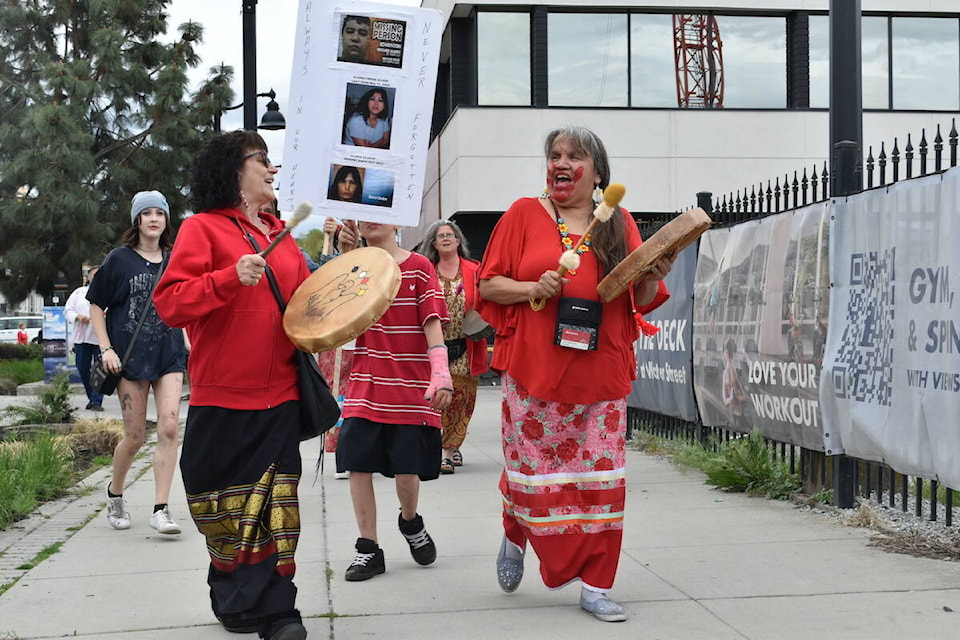Warning: This story contains graphic descriptions and images that some may find disturbing
For Carol Archie, she has lived through the reality of Red Dress Day.
Archie is the niece – from her mom’s side – of a murdered Indigenous woman.
“She was brutally raped and murdered and the individuals that were responsible for her death, two of them were provided small fines and one was able to walk away free, none of them had jail time. This is our reality. We were born and raised with the mindset that we have to be aware of the dangers, not out in the wilderness, in community,” said Archie, who spoke at Kelowna’s Red Dress Day march Friday (May 5).
While wearing red and holding signs, the group of hundreds marched from the friendship society on Leon Avenue before eventually ending up at the Kelowna Court House to bring awareness to Missing and Murdered Indigenous Women and Girls (MMIWG) and the ongoing violent epidemic throughout North America against Indigenous women and girls.
While Red Dress Day has been commemorated for more than a decade, Friday marked the first time the Ki-Low-Na Friendship Society held an event.
Indigenous people have been targets for years and Archie still sees that today.
“I have the ability to be able to work for an employer that understands where I’m coming from because in this day and age, my youngest daughter was followed from my work to her school,” said Archie, who has two daughters, 19 and 16. “I know to make certain I get to work extra early in the morning and my day ends when her day ends so that way I know I’m the one driving her home and I’m the one picking her up, because we are visitors on the Sylix traditional unceded territory so we don’t have a lot of family here.”
Ki-Low-Na Friendship Society executive director Edna Terbasket said it warmed her heart to see the support Friday.
“The message is getting out there to many, many people,” said Terbasket. “We’ve lived with it for a long time as Indigenous people and when I see a lot of the folks here that are from the mainstream, I go ‘Wow, we’re getting our message out there.’”
Terbasket explained red is symbolic because it’s spiritual to Indigenous people. It also stands for the violence behind what’s been happening, at the same time representing love.
“I think families talk more with their children about safety and even lifestyle and taking good care of themselves,” said Terbasket. “It’s not only Indigenous women and girls, it’s all peoples. I couldn’t imagine if I lost a sister or a niece or a granddaughter and she wasn’t found, I couldn’t imagine that. Is she alive? Is she okay? Has she been brutally assaulted or murdered?”
Both Terbasket and Archie have seen tremendous growth and awareness, especially since the remains of 215 Indigenous residential school children were found in Kamloops almost two years ago.
“What we are doing here today, we’re becoming stronger as a people, we are being more aware of who we are as a people and how we contribute to our families, communities, and nation,” said Archie. “Having this awareness across Canada and North America is huge for us, and it all started with residential school. That ripple effect comes into today and we’re answering back with our own ripple effects and it’s becoming more powerful.”
And for more people who want to become aware, learn, and be a part of the solution, Terbasket and Archie say to ask questions and have open conversations.
“We all have to work together, collaborate together, heal together,” said Terbasket.
READ MORE: West Kelowna RCMP asking for public’s help in finding missing 13-year-old boy
READ MORE: From great tips to saving lives, Kelowna Uride drives into Penticton
@cunninghamjordy
jordy.cunningham@kelownacapnews.com
Like us on Facebook and follow us on Twitter.
